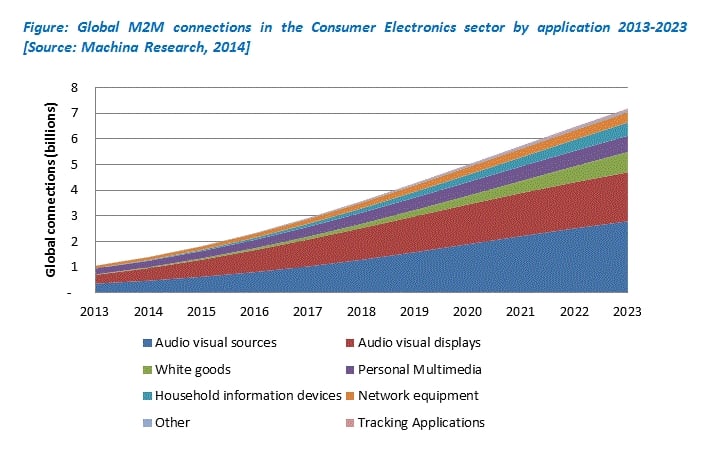The consumer electronics segment is one of the leading segments that is seeing increased adoption in M2M connectivity. The idea of being able to connect a TV or a refridgerator to the network opens up various possibilities that have the potential of facilitating our daily lives and enabling us to save on electricity, time and complete our chores more efficiently.
Machina Research, a technology research and consulting firm, via its “Machine-to-Machine (M2M) Communications in Consumer Electronics 2013-23” report, predicts that the market for M2M connected Consumer Electronics will be worth USD697 billion in nominal terms in 2023 (USD540 billion in real (2011) terms) with almost 7.2 billion devices being 'connected' across the world. The research says that Audio Visual Sources and Audio Visual Displays are the two top categories that will be leading the CE sector in terms of connectivity, with expected numbers of 2.8 billion and 1.9 billion devices respectively. These two segments are also expected to lead in terms of revenue contribution in this M2M segment.
Machina Research also said that the White Goods market is expected to pick up much later compared to the Audio Visual Sources and Displays, which are currently driven by the use of Mobile Gaming Consoles, web-TV, smart TVs and Internet Audio Sources, where connectivity enables users to access a wide range of web content in real time via cheaper and flexible online subscription packages. According to the research, Asia-Pacific, Europe and North America are the largest regional markets with shares of 42%, 22% and 17% of the global revenue in 2013 and 32%, 26% and 19% in 2023.
“There is massive potential for growth in the number of connected CE devices, driven largely by the potential for connected devices to offer a better user experience than non-connected equivalents, for instance in the form of internet-enabled TVs. Over time, a second main driver starts to emerge in the form of connecting white goods to allow time-shifting of electricity usage.”
- Emma Buckland, Principal Analyst at Machina Research




















